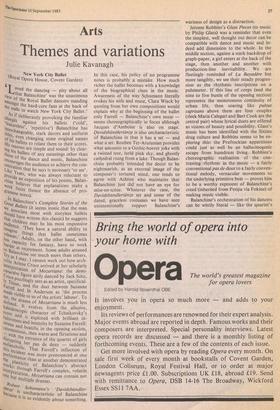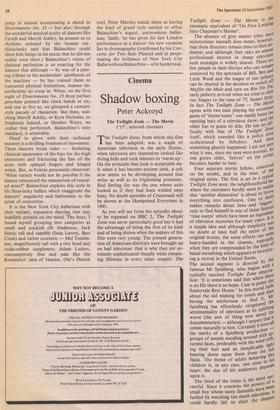Arts
Themes and variations
Julie Kavanagh
New York City Ballet
(Royal Opera House, Covent Garden) Loved the dancing — pity about all that Balanchine' was the unanimous view of the Royal Ballet dancers standing n litintigst the hard-core fans at the back of the stalls to watch New York City Ballet.' ,,,As if deliberately provoking the familiar "arges against his ballets ('cold', :featureless', `repetitive') Balanchine has laterchangeable, stark decors and uniform titles, even changing some original names °II his ballets to relate them to their scores. s ,teasons are simple and sound: by clear- n t" is ballets of any meanings other than c'se of the dance and music, Balanchine —etnitages the audience to achieve the con- cientration that he says is necessary 'to see'. Ike Yeats, who was always reluctant to Provide an exposition of his poems, Balan- elline believes that explanations make a w(3rk te (hence the absence of pro- gratin-tie notes). G In Balanchine's Complete Stories of the ecu Ballets (it seems ironic that the man
we .
sh -"°clate most with storyless ballets nuld have written this classic) he suggests mat alia, children may be his most responsive hiZettIce. 'They have a natural ability to things that ballet sometimes ieleases.' Adults, on the other hand, with he:sricaPacity for fantasy, have to work t "1-'4 at enjoyment. Some adults attuned Yr Balanchine see much more than others. aS I maY, I cannot work out how arch- i '1"c Arlene Croce arrived at her scholarly entetPretation of Mozartiana: the derni- Croce figure airily danced by Jack Soto,
1' Puzzlingly sees as an artist, specifical-
F,arr itian, and the duet between Suzanne n
_eit
and lb Anderson as 'the process irriaae visible to us of the artists' labour'. To d the drama of Mozartiana is much less knelel? ed• It evolves from the allusive, s,..,,_id°seoPic character of Tchaikovsky's
A
""" is explored with brilliant in- serene and intensity by Suzanne Farrell: jene and beatific in the opening section, lettionious, then warm and flirtatious and disrupt. the entrance of the quartet of girls in'erlupting her pas de deux — suddenly thi-a:Pc11,°Iie. That Farrell's inflection of incident was more pronounced at one Performance than at another demonstrated the n L.PlastY of Balanchine's abstract iW„--,t's: through Farrell's complex, volatile ,s7`etPretation, Alozartiana can contain not ,nle but multiple dramas. toRobert Schumann 's Davidsbiindler- bnze' is uncharacteristic of Balanchine ecause it is 50 evidently about something. In this case, his policy of no programme notes is probably a mistake. How . much richer the ballet becomes with a knowledge of the biographical clues in the music. Awareness of the way Schumann literally evokes his wife and muse, Clara Wieck by quoting from her own compositions would explain why at the beginning of the ballet only Farrell — Balanchine's own muse — seems choreographically in focus although Jacques d'Amboise is also on stage. pavidsbiindlerteinze is also uncharacteristic of Balanchine in that it has a set — and what a set: Rouben Ter-Arutunian provides what amounts to a Gothic-horror joke with a twisted tree, lurid pink sky, and ghostly cathedral rising from a lake. Though Balan- chine probably intended the decor to be nightmarish, as an external image of the composer's tortured mind, one tends to agree with Ashton who maintains that Balanchine just did not have an eye for mise-en-scene. Whatever the case, the Davidsbandlertanze set and some of the dated, graceless costumes we have seen unintentionally support Balanchine's
wariness of design as a distraction.
Jerome Robbins's Glass Pieces (to music by Philip Glass) was a reminder that even the simplest, well thought out decor can be compatible with dance and music and in- deed add dimension to the whole. In the middle section, against a stark backdrop of graph-paper, a girl enters at the back of the stage, then another and another with production-line inevitability. We are fleetingly reminded of La Bayadere but more tangibly, we see their steady progres- sion as the rhythmic inscriptions on a pulsimeter. If this line of corps (and the nine to five bustle of the openfrig section) represents the monotonous continuity of urban life, then soaring like pulsus caprisans above them are four couples (sleek Maria Calegari and Bart Cook are the central pair) whose lyrical duets are offered as visions of beauty and possibility. Glass's music has been identified with the Sixties drug culture and Robbins seems to be ex- ploring this: the Prufrockian apparitions could just as well be an hallucinogenic escape from humdrum living. Robbins's choreographic realisation of the con- trasting I rhythms in the music — a fairly conventional pas de deux to a fairly conven- tional melody, vernacular movements to the underlying primitive beat — proves him to be a worthy exponent of Balanchine's creed (inherited from Petipa via Fokine) of making music visible.
Balanchine's orchestration of his dancers can be wittily literal — like the quartet's
jump in unison accentuating a chord in Divertimento No. 15 — but also, through the wonderful musical acuity of dancers like Farrell and Merrill Ashley, he attunes us to rhythms unheard by the human ear. (Stravinsky said that Balanchine could show him things in his music that he did not realise were there.) Balanchine's vision of classical perfection is so exacting for the dancers that although — by way of a pass- ing tribute to the modernists' apotheosis of the machine — he has trained them to transcend physical limitations, human im- perfections do creep in. When, on the first night of Divertimento No. 15 three perfect penchees pointed like clock hands at six, and one at five to, we glimpsed a concert- style parody of classicism. But then, wat- ching Merrill Ashley, or Kyra Nicholas, or Stephanie Saland, or Heather Watts, we realise that perfection, Balanchine's only standard, is attainable.
Hand in glove with their technical mastery is a thrilling freedom of movement. These dancers break rules — forfeiting classical squareness of the hips for sky-high extensions and fracturing the line of the arms with splayed fingers and hinged wrists. But, as Fokine presciently observed: 'What variety would not be possible if the dancer renounced the mannerism of round- ed arms?' Balanchine exploits this style in his Stravinsky ballets which exaggerate the dancers' angularity and limberness to the point of contortion.
It is the New York City ballerinas with their radiant, expansive dancing that stay indelibly printed on the mind. The boys, I found myself grouping into categories as small and puckish (lb Anderson, Jack Soto); tall and capable (Sean Lavery, Bart
Cook) and rather eccentric — Mel Tomlin- son, magnificently tall with a tiny head and india-rubber suppleness; Adam Luders, consumptively thin and pale like the Romantics' idea of Hamlet. (He's Danish
too). Peter Martins stands alone as having the kind of grand style needed to offset Balanchine's august, autonomous baller- inas. Sadly, he has given his last London performance as a dancer: his new vocation lies in choreography (confirmed by his Con- certo for Two Solo Pianos) and in perpe- tuating the brilliance of New York City Ballet without Balanchine— a farhardertask .







































 Previous page
Previous page